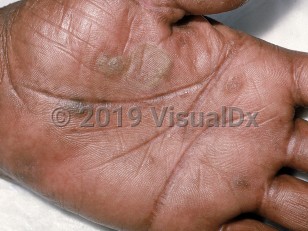EB simplex is the most common form of EB. It is most often caused by mutations within the genes encoding for keratins-5 and -14, with the vast majority being autosomal dominantly transmitted. There are 2 major types of EB simplex, basilar and suprabasilar, based on the ultrastructural site within which blisters arise. Most subtypes are basilar. On the basis of collective clinical findings, in conjunction with ultrastructural and molecular data, basilar EB simplex is further divided into 3 main subtypes:
- EBS, localized (EBS-loc; formerly known as EB simplex Weber-Cockayne), the mildest EB simplex subtype, is associated with blisters primarily limited to the palms and soles.
- EBS, generalized severe (EBS-gen sev; formerly known as Dowling-Meara type) is a severe subtype characterized by widespread blistering, herpetiform or arcuate grouping of blisters, possible internal organ involvement (to rarely include the upper airway), and the potential for death in the neonatal period.
- EBS, generalized intermediate (EBS-gen intermed; formerly known as Koebner type), is an EB simplex subtype having more widespread cutaneous involvement than EBS-loc but little or no extracutaneous disease activity.
In the mildest cases of EB simplex, first signs may not develop until the child begins to walk or crawl, whereas large bullae and erosions are usually present at birth or within the first days of life in infants having a generalized EB simplex subtype. All forms of EB simplex worsen in hot, humid environments, and most improve with age. Treatment is supportive.
There are some patients with a dominant mutation that promotes ubiquitination and excessive proteolysis of KRT14.
Related topic: epidermolysis bullosa acquisita



